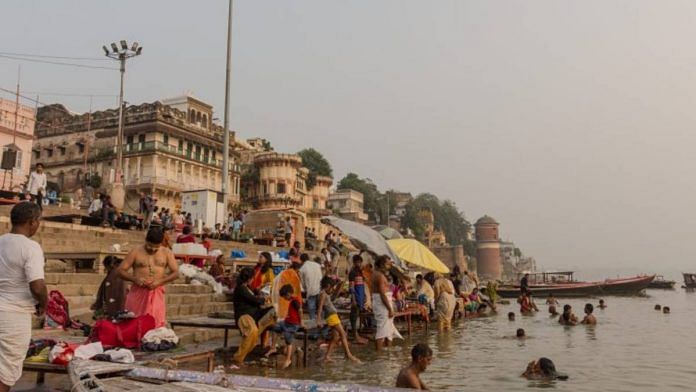New Delhi: A new study has found the Ganga to be heavily polluted by microplastics, the highest concentration of which is in Varanasi.
The result of the study titled, ‘Quantitative analysis of Microplastics along River Ganga’, was released by Delhi-based NGO Toxics Link Thursday. The study found the river’s water to have been polluted by multiple kinds of plastic, comprising both single-use and secondary plastic products.
Microplastics are defined as plastics that are less than 5 mm in length and are recognised as a major source of marine pollution, causing significant concern.
Untreated sewage from cities along the river’s course, the release of industrial waste into the river, and religious offerings — wrapped in non-degradable plastics — add large quantities of pollutants to the Ganga water, noted the study. The plastic products and waste materials released or dumped in the river break down and are eventually reduced to microparticles, which are ultimately carried into the oceans by the river water, it added.
The river water testing was carried out in collaboration with the National Institute of Oceanography in Goa and samples were collected from the Ganga at Haridwar, Kanpur, and Varanasi, in February 2020. At each of these places, five water samples were collected from the river.
The samples were tested through the Fourier transform infrared (FTIR) spectroscopy — a technique used to identify small organic or inorganic material — to identify the exact type, or resin core present in the water, and the results showed the presence of 40 different kinds of polymers as microplastics in Ganga waters. Resins like EVOH, Polyacetylene, PIP, PVC and PVAL were predominantly present in all three locations, the study found.
“Essentially all along microplastics are flowing into the river system. It does reflect or suggest a direct linkage between the poor state of both solid and liquid waste management; hence it is critically important to initiate steps to remediate it,” the report quoted Priti Mahesh, Chief Coordinator at Toxics Link, as saying.
Also read: It’s 2021, but floating bodies in UP and Bihar have sent us back to 1918
‘Assi Ghat most polluted’
Among samples collected from the three cities, those from Varanasi showed the maximum presence of microplastics. The results indicate greater microplastic pollution in the downstream river, from Haridwar to Varanasi.
The sample collected near Assi Ghat in Varanasi had the maximum presence of microplastics, the report stated. Within Varanasi, samples were also collected between Kedar Ghat and Pandey Ghat, Sheetala Ghat and Gaay ghat, and Sankatha Ghat and Dashashwamedh Ghat.
The Ganga was found to be polluted with plastic waste, mainly single-use and secondary plastic products. Black and brown particles were found to be more in number, followed by coloured particles at all three locations. The dominance of black particles also suggests its origin to have been abrasion of tires, the report stated.
Microplastic pollution in the Ganga can have many ramifications, as its water is used for various purposes that can lead to severe impacts on the environment, as well as human health, the study observed. Though there is currently inadequate information on health impacts, it is a fact that plastics are laced with multiple types of additives and chemicals that are known toxins that could be leaching into the water, it explained.
According to existing studies, microplastics can pass through water filtration systems and enter the human body. Discarded plastic waste contributes to marine pollution, with devastating consequences for marine life and the habitats they depend on and affects the food web due to its intake by marine organisms.
The study also compared the microplastic concentration in the Ganga, to that found in rivers such as the Rhine in Europe, the Patapsco, Magothy and Rhode in North America and the Elqui, Maipo, Biobio, and Maule in South America, according to other global studies, and found its presence to be higher in the Ganga. This in spite of a higher per capita consumption of plastic in European states and North and South America, as compared to India, noted the report.
Also read: Five reasons that are stopping Ganga from becoming clean




